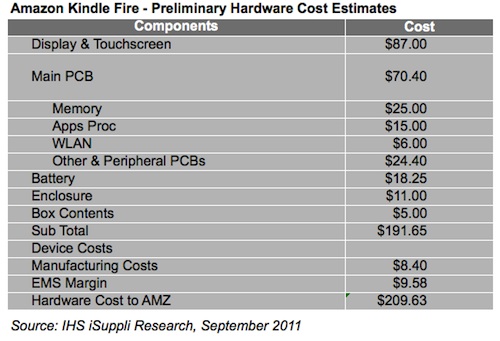 IHS iSuppli announced its preliminary estimates put the total cost of manufacture for Amazon’s new Kindle Fire tablet at $209.63.
IHS iSuppli announced its preliminary estimates put the total cost of manufacture for Amazon’s new Kindle Fire tablet at $209.63.
For more information visit: www.isuppli.com
Unedited press release follows:
IHS iSuppli News Flash: Amazon Sells Kindle Fire at Low Profit Margin to Promote Online Merchandize Sales
An IHS analysis reveals Amazon’s business model for its new Kindle Fire tablet, with the company willing to settle for a razor-thin margin on sales of devices and digital content in order to achieve the larger goal of promoting merchandize sales at its online store.
A preliminary virtual estimate conducted by the IHS iSuppli Teardown Analysis Service places Kindle Fire’s bill of materials (BOM) cost at $191.65. With the addition of manufacturing expenses, the total cost to produce the Kindle Fire rises to $209.63, as presented in the table below.
When further costs outside of materials and manufacturing are added in—and the $199 price of the tablet is factored along with the expected sales of digital content per device—Amazon is likely to generate a marginal profit of $10 on each Kindle Fire sold.
However, the real benefit of the Kindle Fire to Amazon will not be in selling hardware or digital content. Rather, the Kindle Fire, and the content demand it stimulates, will serve to promote sales of the kinds of physical goods that comprise the majority of Amazon’s business. Amazon doesn’t make a substantial profit on sales of Kindle hardware and content such as e-books and music. Instead, the Seattle-based online-retail giant generates its profits on sales of shoes, diapers, and every other kind of physical product imaginable. Similar to Walmart and other large brick-and-motor retailers, Amazon’s content business is designed to lure in consumers to buy such everyday goods as well as other money-making items.
The importance of this strategy cannot be underestimated. So far, no retailer has managed to create an umbilical link between digital content and a more conventional retail environment. With Kindle, Amazon has created the most convincing attempt at this yet, and it is doing so by using established retail tactics: deploying content to get shoppers in the door, and then selling them all sorts of other goods. This is exactly how Walmart, Target and others use a similar weapon—in their case, DVDs. If doing this means that Amazon must take a loss on the sales of digital content and tablet hardware, it will be well worth it in the end.
This business model is unique to Amazon. No other tablet brand or e-book reader operates such a broad retail service, which generated $34 billion in revenue in 2010. Conversely no other retailer can offer a tablet specifically designed to promote sales of its goods.
With its use of the Android operating system, the Kindle Fire is a multifunction device. Therefore, while its main use is as a color e-book reader, it also has a browser for surfing the Web and the capability to load apps. Such capabilities put the Kindle Fire in the tablet category—although it is more a “super e-book reader” than a low-cost tablet.
This is a critical difference in the perception of the customer and in setting their expectations. While some say the super e-book reader approach of the Kindle Fire means it falls short of the iPad’s capabilities, IHS believes it actually represents an enhancement of the e-book reader, which will serve to expand both the e-book reader and tablet markets. Because of this, IHS believes the Kindle Fire will be a successful product.
With its lower pricing than the iPad, and its positioning as a super eReader, the Kindle Fire may serve in fact to expand the tablet market beyond current expectations. As such, the Kindle Fire potentially could become the No. 2 selling tablet after the iPad.
The Amazon Kindle Fire tablet likely leverages design elements and component selections from the Playbook tablet from Research in Motion Ltd. Both the Kindle Fire and the PlayBook are manufactured by Taiwanese electronics contract manufacturer Quanta Computer Inc. Because Quanta engages in product design, it likely is repurposing much of the expertise it gained from developing the PlayBook for use in the Kindle Fire.
The preliminary virtual teardown of the Kindle Fire estimates that display/touch screen is the most expensive subsystem of the device, at $87.00.
The applications processor in the Kindle Fire likely a dual core device, priced at $15.00.
The IHS iSuppli Teardown Analysis Team plans to conduct a complete physical teardown of the Kindle Fire when the product begins shipping.
About IHS (www.ihs.com)
IHS (NYSE: IHS) is the leading source of information and insight in critical areas that shape today’s business landscape, including energy and power; design and supply chain; defense, risk and security; environmental, health and safety (EHS) and sustainability; country and industry forecasting; and commodities, pricing and cost. Businesses and governments in more than 165 countries around the globe rely on the comprehensive content, expert independent analysis and flexible delivery methods of IHS to make high-impact decisions and develop strategies with speed and confidence. IHS has been in business since 1959 and became a publicly traded company on the New York Stock Exchange in 2005. Headquartered in Englewood, Colorado, USA, IHS employs more than 5,100 people in more than 30 countries around the world.
